Alfa Romeo 4C 2016 Owner handbook (in English)
Manufacturer: ALFA ROMEO, Model Year: 2016, Model line: 4C, Model: Alfa Romeo 4C 2016Pages: 182, PDF Size: 9.49 MB
Page 141 of 182
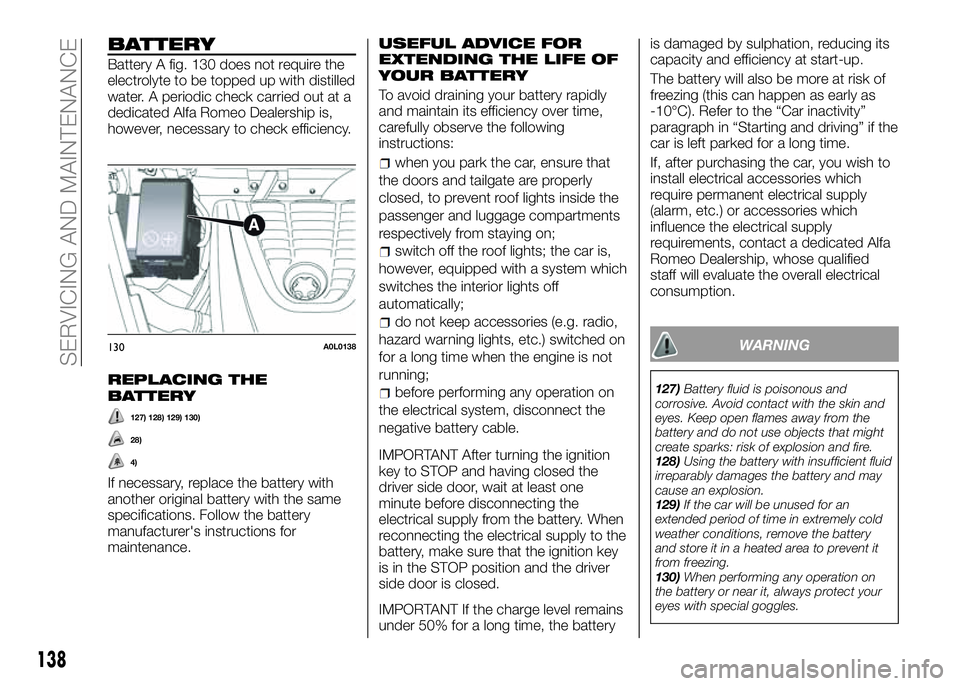
BATTERY
Battery A fig. 130 does not require the
electrolyte to be topped up with distilled
water. A periodic check carried out at a
dedicated Alfa Romeo Dealership is,
however, necessary to check efficiency.
REPLACING THE
BATTERY
127) 128) 129) 130)
28)
4)
If necessary, replace the battery with
another original battery with the same
specifications. Follow the battery
manufacturer's instructions for
maintenance.
USEFUL ADVICE FOR
EXTENDING THE LIFE OF
YOUR BATTERY
To avoid draining your battery rapidly
and maintain its efficiency over time,
carefully observe the following
instructions:
when you park the car, ensure that
the doors and tailgate are properly
closed, to prevent roof lights inside the
passenger and luggage compartments
respectively from staying on;
switch off the roof lights; the car is,
however, equipped with a system which
switches the interior lights off
automatically;
do not keep accessories (e.g. radio,
hazard warning lights, etc.) switched on
for a long time when the engine is not
running;
before performing any operation on
the electrical system, disconnect the
negative battery cable.
IMPORTANT After turning the ignition
key to STOP and having closed the
driver side door, wait at least one
minute before disconnecting the
electrical supply from the battery. When
reconnecting the electrical supply to the
battery, make sure that the ignition key
is in the STOP position and the driver
side door is closed.
IMPORTANT If the charge level remains
under 50% for a long time, the batteryis damaged by sulphation, reducing its
capacity and efficiency at start-up.
The battery will also be more at risk of
freezing (this can happen as early as
-10°C). Refer to the “Car inactivity”
paragraph in “Starting and driving” if the
car is left parked for a long time.
If, after purchasing the car, you wish to
install electrical accessories which
require permanent electrical supply
(alarm, etc.) or accessories which
influence the electrical supply
requirements, contact a dedicated Alfa
Romeo Dealership, whose qualified
staff will evaluate the overall electrical
consumption.
WARNING
127)Battery fluid is poisonous and
corrosive. Avoid contact with the skin and
eyes. Keep open flames away from the
battery and do not use objects that might
create sparks: risk of explosion and fire.
128)Using the battery with insufficient fluid
irreparably damages the battery and may
cause an explosion.
129)If the car will be unused for an
extended period of time in extremely cold
weather conditions, remove the battery
and store it in a heated area to prevent it
from freezing.
130)When performing any operation on
the battery or near it, always protect your
eyes with special goggles.
130A0L0138
138
SERVICING AND MAINTENANCE
Page 142 of 182
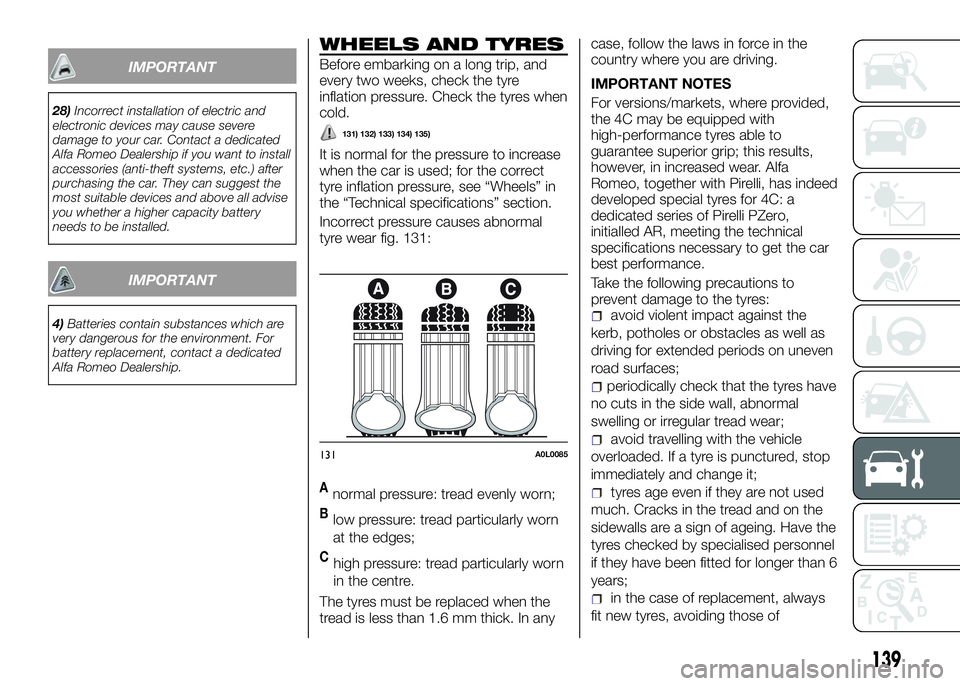
IMPORTANT
28)Incorrect installation of electric and
electronic devices may cause severe
damage to your car. Contact a dedicated
Alfa Romeo Dealership if you want to install
accessories (anti-theft systems, etc.) after
purchasing the car. They can suggest the
most suitable devices and above all advise
you whether a higher capacity battery
needs to be installed.
IMPORTANT
4)Batteries contain substances which are
very dangerous for the environment. For
battery replacement, contact a dedicated
Alfa Romeo Dealership.
WHEELS AND TYRES
Before embarking on a long trip, and
every two weeks, check the tyre
inflation pressure. Check the tyres when
cold.
131) 132) 133) 134) 135)
It is normal for the pressure to increase
when the car is used; for the correct
tyre inflation pressure, see “Wheels” in
the “Technical specifications” section.
Incorrect pressure causes abnormal
tyre wear fig. 131:
Anormal pressure: tread evenly worn;
Blow pressure: tread particularly worn
at the edges;
Chigh pressure: tread particularly worn
in the centre.
The tyres must be replaced when the
tread is less than 1.6 mm thick. In anycase, follow the laws in force in the
country where you are driving.
IMPORTANT NOTES
For versions/markets, where provided,
the 4C may be equipped with
high-performance tyres able to
guarantee superior grip; this results,
however, in increased wear. Alfa
Romeo, together with Pirelli, has indeed
developed special tyres for 4C: a
dedicated series of Pirelli PZero,
initialled AR, meeting the technical
specifications necessary to get the car
best performance.
Take the following precautions to
prevent damage to the tyres:
avoid violent impact against the
kerb, potholes or obstacles as well as
driving for extended periods on uneven
road surfaces;
periodically check that the tyres have
no cuts in the side wall, abnormal
swelling or irregular tread wear;
avoid travelling with the vehicle
overloaded. If a tyre is punctured, stop
immediately and change it;
tyres age even if they are not used
much. Cracks in the tread and on the
sidewalls are a sign of ageing. Have the
tyres checked by specialised personnel
if they have been fitted for longer than 6
years;
in the case of replacement, always
fit new tyres, avoiding those of
131A0L0085
139
Page 143 of 182
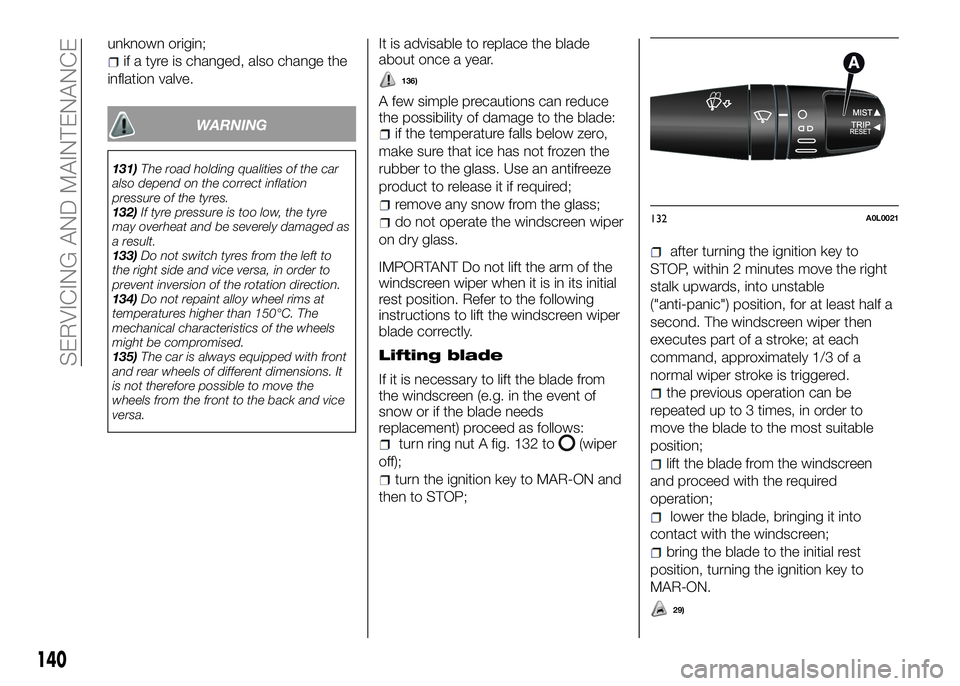
unknown origin;
if a tyre is changed, also change the
inflation valve.
WARNING
131)The road holding qualities of the car
also depend on the correct inflation
pressure of the tyres.
132)If tyre pressure is too low, the tyre
may overheat and be severely damaged as
a result.
133)Do not switch tyres from the left to
the right side and vice versa, in order to
prevent inversion of the rotation direction.
134)Do not repaint alloy wheel rims at
temperatures higher than 150°C. The
mechanical characteristics of the wheels
might be compromised.
135)The car is always equipped with front
and rear wheels of different dimensions. It
is not therefore possible to move the
wheels from the front to the back and vice
versa.
It is advisable to replace the blade
about once a year.
136)
A few simple precautions can reduce
the possibility of damage to the blade:
if the temperature falls below zero,
make sure that ice has not frozen the
rubber to the glass. Use an antifreeze
product to release it if required;
remove any snow from the glass;
do not operate the windscreen wiper
on dry glass.
IMPORTANT Do not lift the arm of the
windscreen wiper when it is in its initial
rest position. Refer to the following
instructions to lift the windscreen wiper
blade correctly.
Lifting blade
If it is necessary to lift the blade from
the windscreen (e.g. in the event of
snow or if the blade needs
replacement) proceed as follows:
turn ring nut A fig. 132 to(wiper
off);
turn the ignition key to MAR-ON and
then to STOP;
after turning the ignition key to
STOP, within 2 minutes move the right
stalk upwards, into unstable
("anti-panic") position, for at least half a
second. The windscreen wiper then
executes part of a stroke; at each
command, approximately 1/3 of a
normal wiper stroke is triggered.
the previous operation can be
repeated up to 3 times, in order to
move the blade to the most suitable
position;
lift the blade from the windscreen
and proceed with the required
operation;
lower the blade, bringing it into
contact with the windscreen;
bring the blade to the initial rest
position, turning the ignition key to
MAR-ON.
29)
132A0L0021
140
SERVICING AND MAINTENANCE
Page 144 of 182
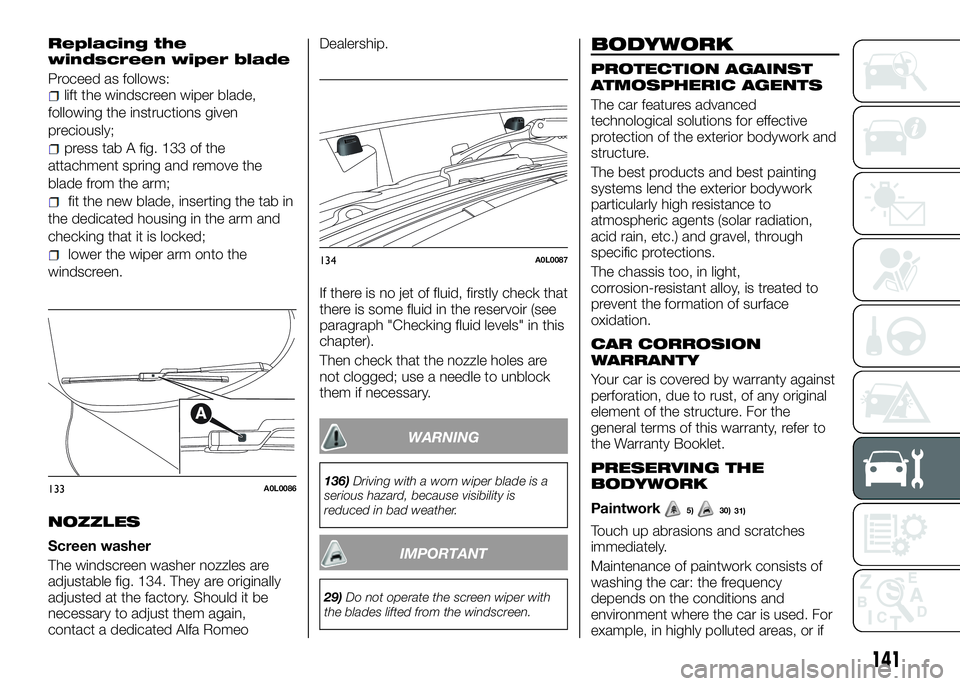
Replacing the
windscreen wiper blade
Proceed as follows:lift the windscreen wiper blade,
following the instructions given
preciously;
press tab A fig. 133 of the
attachment spring and remove the
blade from the arm;
fit the new blade, inserting the tab in
the dedicated housing in the arm and
checking that it is locked;
lower the wiper arm onto the
windscreen.
NOZZLES
Screen washer
The windscreen washer nozzles are
adjustable fig. 134. They are originally
adjusted at the factory. Should it be
necessary to adjust them again,
contact a dedicated Alfa RomeoDealership.
If there is no jet of fluid, firstly check that
there is some fluid in the reservoir (see
paragraph "Checking fluid levels" in this
chapter).
Then check that the nozzle holes are
not clogged; use a needle to unblock
them if necessary.
WARNING
136)Driving with a worn wiper blade is a
serious hazard, because visibility is
reduced in bad weather.
IMPORTANT
29)Do not operate the screen wiper with
the blades lifted from the windscreen.
BODYWORK
PROTECTION AGAINST
ATMOSPHERIC AGENTS
The car features advanced
technological solutions for effective
protection of the exterior bodywork and
structure.
The best products and best painting
systems lend the exterior bodywork
particularly high resistance to
atmospheric agents (solar radiation,
acid rain, etc.) and gravel, through
specific protections.
The chassis too, in light,
corrosion-resistant alloy, is treated to
prevent the formation of surface
oxidation.
CAR CORROSION
WARRANTY
Your car is covered by warranty against
perforation, due to rust, of any original
element of the structure. For the
general terms of this warranty, refer to
the Warranty Booklet.
PRESERVING THE
BODYWORK
Paintwork5)30)
Touch up abrasions and scratches
immediately.
Maintenance of paintwork consists of
washing the car: the frequency
depends on the conditions and
environment where the car is used. For
example, in highly polluted areas, or if
133A0L0086
134A0L0087
141
31)
Page 145 of 182
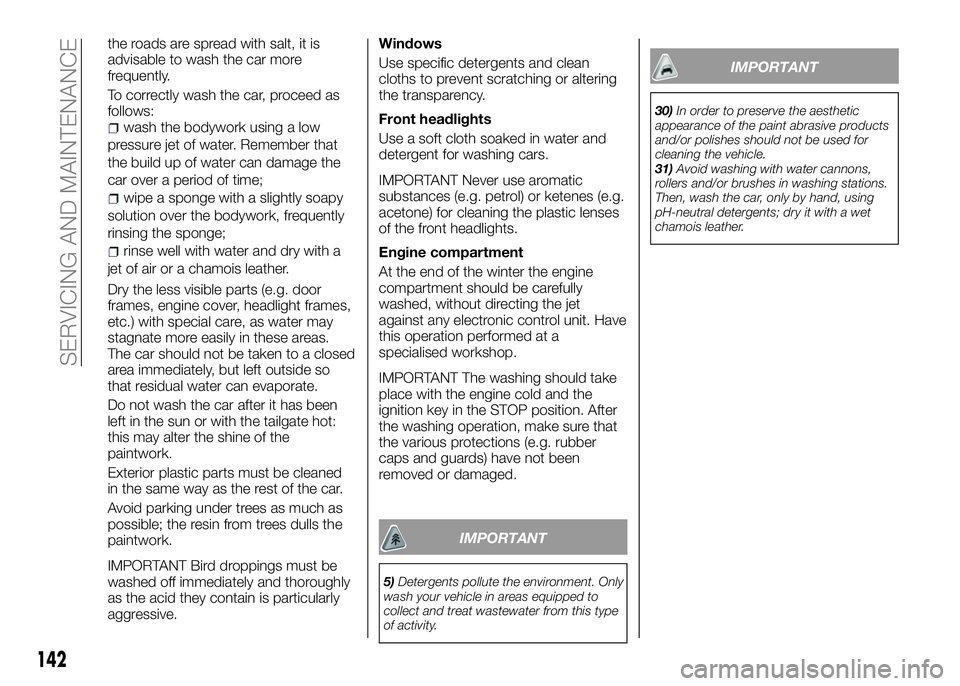
the roads are spread with salt, it is
advisable to wash the car more
frequently.
To correctly wash the car, proceed as
follows:
wash the bodywork using a low
pressure jet of water. Remember that
the build up of water can damage the
car over a period of time;
wipe a sponge with a slightly soapy
solution over the bodywork, frequently
rinsing the sponge;
rinse well with water and dry with a
jet of air or a chamois leather.
Dry the less visible parts (e.g. door
frames, engine cover, headlight frames,
etc.) with special care, as water may
stagnate more easily in these areas.
The car should not be taken to a closed
area immediately, but left outside so
that residual water can evaporate.
Do not wash the car after it has been
left in the sun or with the tailgate hot:
this may alter the shine of the
paintwork.
Exterior plastic parts must be cleaned
in the same way as the rest of the car.
Avoid parking under trees as much as
possible; the resin from trees dulls the
paintwork.
IMPORTANT Bird droppings must be
washed off immediately and thoroughly
as the acid they contain is particularly
aggressive.Windows
Use specific detergents and clean
cloths to prevent scratching or altering
the transparency.
Front headlights
Use a soft cloth soaked in water and
detergent for washing cars.
IMPORTANT Never use aromatic
substances (e.g. petrol) or ketenes (e.g.
acetone) for cleaning the plastic lenses
of the front headlights.
Engine compartment
At the end of the winter the engine
compartment should be carefully
washed, without directing the jet
against any electronic control unit. Have
this operation performed at a
specialised workshop.
IMPORTANT The washing should take
place with the engine cold and the
ignition key in the STOP position. After
the washing operation, make sure that
the various protections (e.g. rubber
caps and guards) have not been
removed or damaged.
IMPORTANT
5)Detergents pollute the environment. Only
wash your vehicle in areas equipped to
collect and treat wastewater from this type
of activity.
IMPORTANT
30)In order to preserve the aesthetic
appearance of the paint abrasive products
and/or polishes should not be used for
cleaning the vehicle.
31)Avoid washing with water cannons,
rollers and/or brushes in washing stations.
Then, wash the car, only by hand, using
pH-neutral detergents; dry it with a wet
chamois leather.
142
SERVICING AND MAINTENANCE
Page 146 of 182
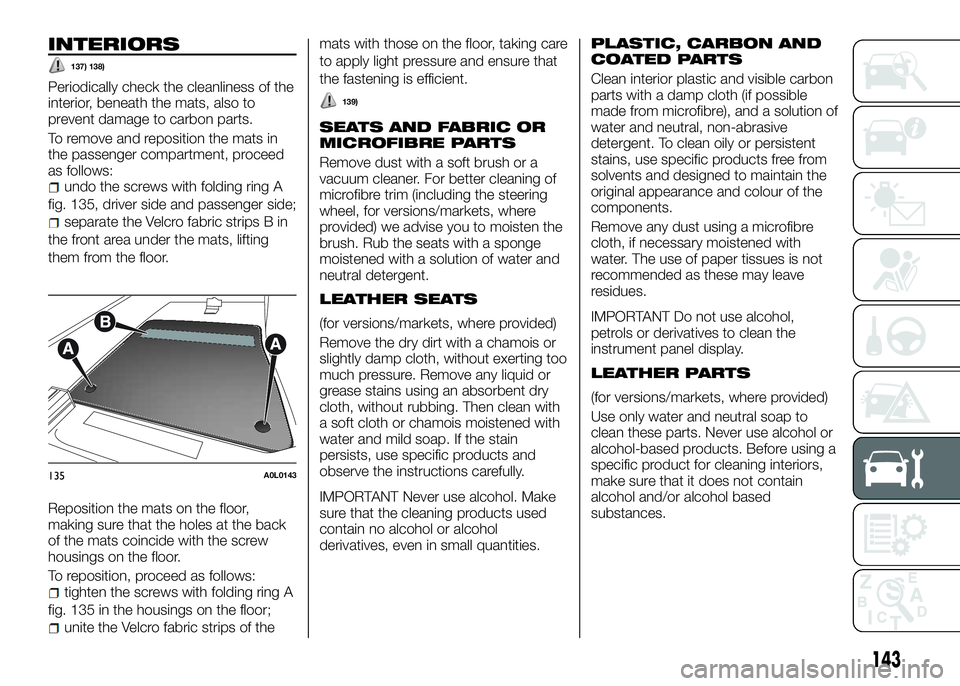
INTERIORS
137) 138)
Periodically check the cleanliness of the
interior, beneath the mats, also to
prevent damage to carbon parts.
To remove and reposition the mats in
the passenger compartment, proceed
as follows:
undo the screws with folding ring A
fig. 135, driver side and passenger side;
separate the Velcro fabric strips B in
the front area under the mats, lifting
them from the floor.
Reposition the mats on the floor,
making sure that the holes at the back
of the mats coincide with the screw
housings on the floor.
To reposition, proceed as follows:
tighten the screws with folding ring A
fig. 135 in the housings on the floor;
unite the Velcro fabric strips of themats with those on the floor, taking care
to apply light pressure and ensure that
the fastening is efficient.
139)
SEATS AND FABRIC OR
MICROFIBRE PARTS
Remove dust with a soft brush or a
vacuum cleaner. For better cleaning of
microfibre trim (including the steering
wheel, for versions/markets, where
provided) we advise you to moisten the
brush. Rub the seats with a sponge
moistened with a solution of water and
neutral detergent.
LEATHER SEATS
(for versions/markets, where provided)
Remove the dry dirt with a chamois or
slightly damp cloth, without exerting too
much pressure. Remove any liquid or
grease stains using an absorbent dry
cloth, without rubbing. Then clean with
a soft cloth or chamois moistened with
water and mild soap. If the stain
persists, use specific products and
observe the instructions carefully.
IMPORTANT Never use alcohol. Make
sure that the cleaning products used
contain no alcohol or alcohol
derivatives, even in small quantities.
PLASTIC, CARBON AND
COATED PARTS
Clean interior plastic and visible carbon
parts with a damp cloth (if possible
made from microfibre), and a solution of
water and neutral, non-abrasive
detergent. To clean oily or persistent
stains, use specific products free from
solvents and designed to maintain the
original appearance and colour of the
components.
Remove any dust using a microfibre
cloth, if necessary moistened with
water. The use of paper tissues is not
recommended as these may leave
residues.
IMPORTANT Do not use alcohol,
petrols or derivatives to clean the
instrument panel display.
LEATHER PARTS
(for versions/markets, where provided)
Use only water and neutral soap to
clean these parts. Never use alcohol or
alcohol-based products. Before using a
specific product for cleaning interiors,
make sure that it does not contain
alcohol and/or alcohol based
substances.
135A0L0143
143
Page 147 of 182
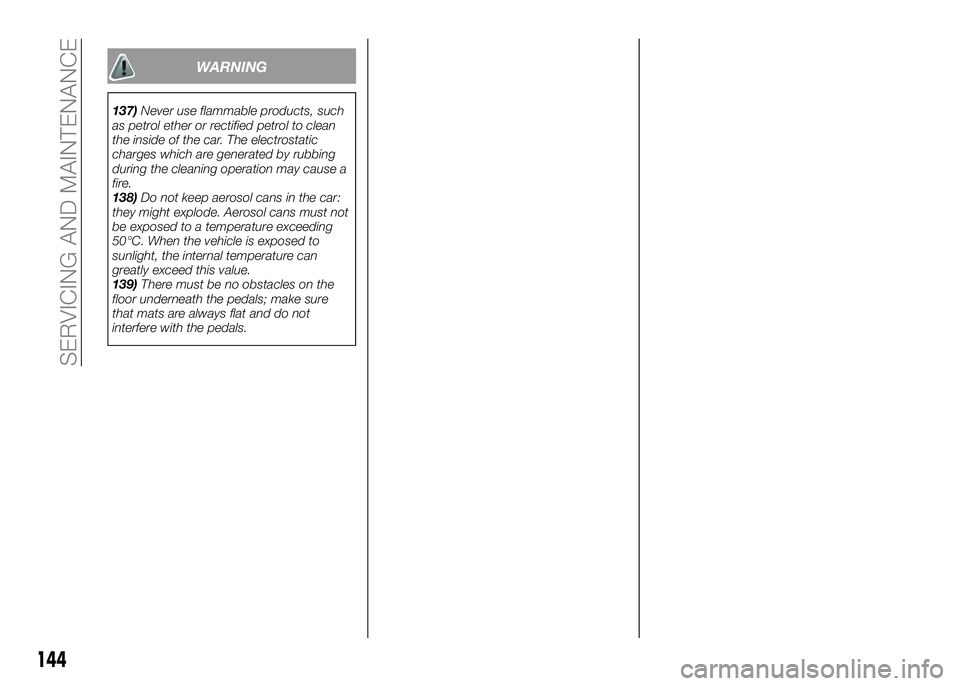
WARNING
137)Never use flammable products, such
as petrol ether or rectified petrol to clean
the inside of the car. The electrostatic
charges which are generated by rubbing
during the cleaning operation may cause a
fire.
138)Do not keep aerosol cans in the car:
they might explode. Aerosol cans must not
be exposed to a temperature exceeding
50°C. When the vehicle is exposed to
sunlight, the internal temperature can
greatly exceed this value.
139)There must be no obstacles on the
floor underneath the pedals; make sure
that mats are always flat and do not
interfere with the pedals.
144
SERVICING AND MAINTENANCE
Page 148 of 182
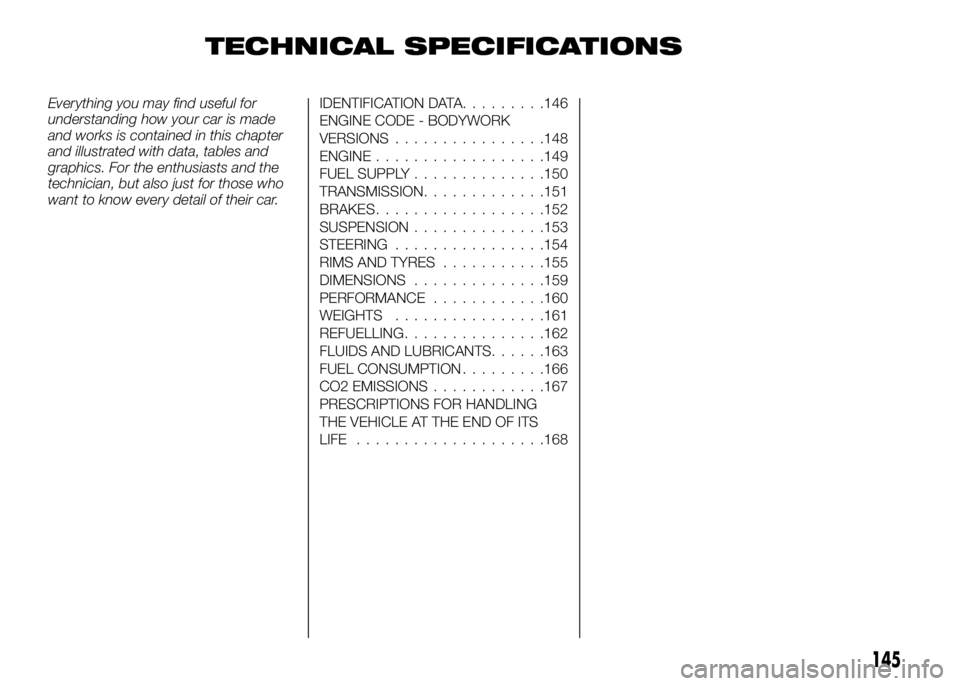
TECHNICAL SPECIFICATIONS
Everything you may find useful for
understanding how your car is made
and works is contained in this chapter
and illustrated with data, tables and
graphics. For the enthusiasts and the
technician, but also just for those who
want to know every detail of their car.IDENTIFICATION DATA.........146
ENGINE CODE - BODYWORK
VERSIONS................148
ENGINE..................149
FUEL SUPPLY..............150
TRANSMISSION.............151
BRAKES..................152
SUSPENSION..............153
STEERING................154
RIMS AND TYRES...........155
DIMENSIONS..............159
PERFORMANCE............160
WEIGHTS................161
REFUELLING...............162
FLUIDS AND LUBRICANTS......163
FUEL CONSUMPTION.........166
CO2 EMISSIONS............167
PRESCRIPTIONS FOR HANDLING
THE VEHICLE AT THE END OF ITS
LIFE....................168
145
Page 149 of 182
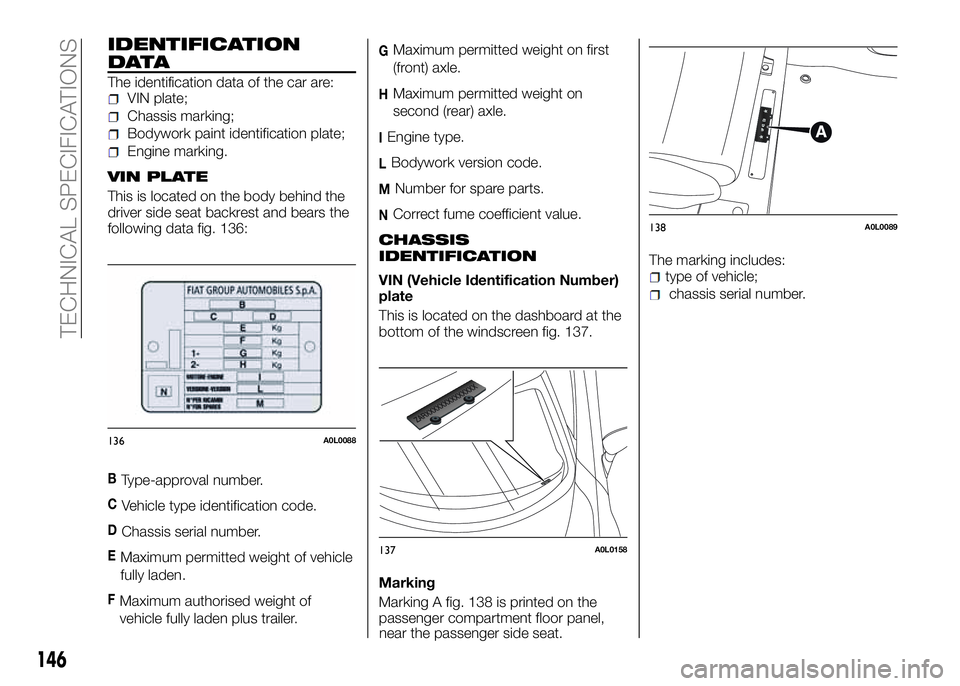
IDENTIFICATION
DATA
The identification data of the car are:VIN plate;
Chassis marking;
Bodywork paint identification plate;
Engine marking.
VIN PLATE
This is located on the body behind the
driver side seat backrest and bears the
following data fig. 136:
BType-approval number.
CVehicle type identification code.
DChassis serial number.
EMaximum permitted weight of vehicle
fully laden.
FMaximum authorised weight of
vehicle fully laden plus trailer.
GMaximum permitted weight on first
(front) axle.
HMaximum permitted weight on
second (rear) axle.
IEngine type.
LBodywork version code.
MNumber for spare parts.
NCorrect fume coefficient value.
CHASSIS
IDENTIFICATION
VIN (Vehicle Identification Number)
plate
This is located on the dashboard at the
bottom of the windscreen fig. 137.
Marking
Marking A fig. 138 is printed on the
passenger compartment floor panel,
near the passenger side seat.The marking includes:type of vehicle;
chassis serial number.
136A0L0088
137A0L0158
138A0L0089
146
TECHNICAL SPECIFICATIONS
Page 150 of 182
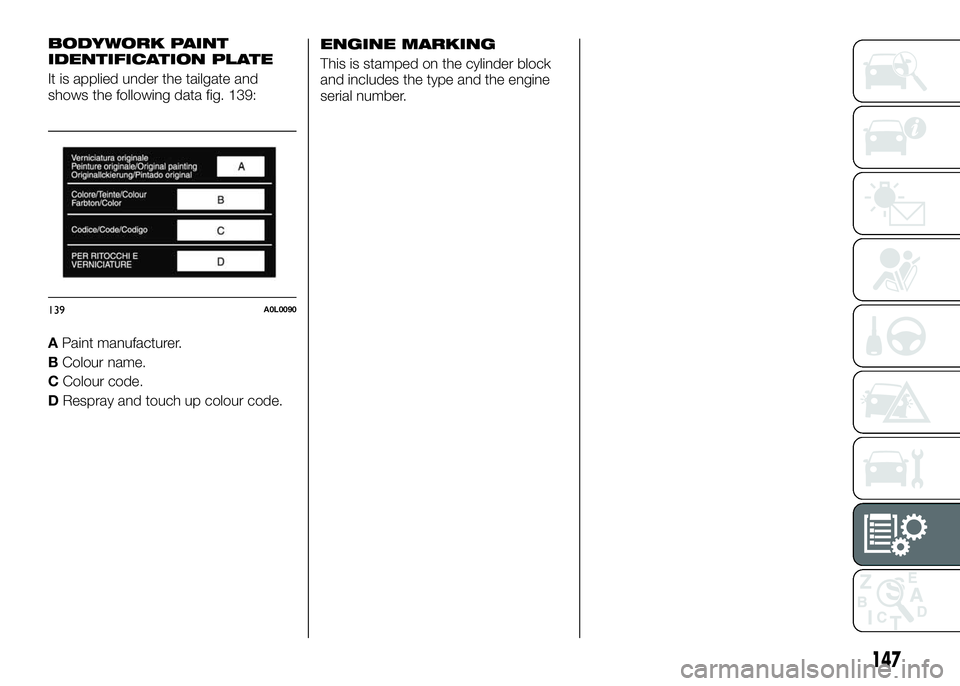
BODYWORK PAINT
IDENTIFICATION PLATE
It is applied under the tailgate and
shows the following data fig. 139:
APaint manufacturer.
BColour name.
CColour code.
DRespray and touch up colour code.
ENGINE MARKING
This is stamped on the cylinder block
and includes the type and the engine
serial number.
139A0L0090
147